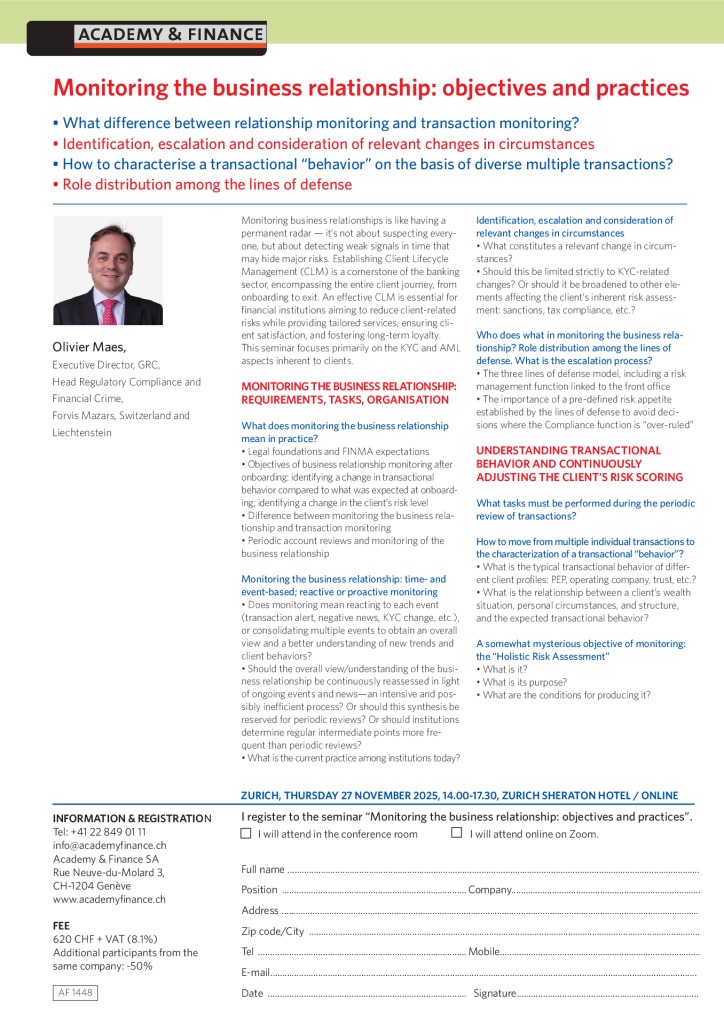> What difference between relationship monitoring and transaction monitoring?
> Identification, escalation and consideration of relevant changes in circumstances
> How to characterise a transactional “behavior” on the basis of diverse multiple transactions?
> Role distribution among the lines of defense
Monitoring business relationships is like having a permanent radar — it’s not about suspecting everyone, but about detecting weak signals in time that may hide major risks. Establishing Client Lifecycle Management (CLM) is a cornerstone of the banking sector, encompassing the entire client journey, from onboarding to exit. An effective CLM is essential for financial institutions aiming to reduce client-related risks while providing tailored services, ensuring client satisfaction, and fostering long-term loyalty. This seminar focuses primarily on the KYC and AML aspects inherent to clients.
MONITORING THE BUSINESS RELATIONSHIP: REQUIREMENTS, TASKS, ORGANISATION
What does monitoring the business relationship mean in practice?
- Legal foundations and FINMA expectations
- Objectives of business relationship monitoring after onboarding: identifying a change in transactional behavior compared to what was expected at onboarding; identifying a change in the client’s risk level
- Difference between monitoring the business relationship and transaction monitoring
- Periodic account reviews and monitoring of the business relationship
Monitoring the business relationship: time- and event-based; reactive or proactive monitoring
- Does monitoring mean reacting to each event (transaction alert, negative news, KYC change, etc.), or consolidating multiple events to obtain an overall view and a better understanding of new trends and client behaviors?
- Should the overall view/understanding of the business relationship be continuously reassessed in light of ongoing events and news—an intensive and possibly inefficient process? Or should this synthesis be reserved for periodic reviews? Or should institutions determine regular intermediate points more frequent than periodic reviews?
- What is the current practice among institutions today?
Identification, escalation and consideration of relevant changes in circumstances
- What constitutes a relevant change in circumstances?
- Should this be limited strictly to KYC-related changes? Or should it be broadened to other elements affecting the client’s inherent risk assessment: sanctions, tax compliance, etc.?
Who does what in monitoring the business relationship? Role distribution among the lines of defense. What is the escalation process?
- The three lines of defense model, including a risk management function linked to the front office
- The importance of a pre-defined risk appetite established by the lines of defense to avoid decisions where the Compliance function is “over-ruled”
UNDERSTANDING TRANSACTIONAL BEHAVIOR AND CONTINUOUSLY ADJUSTING THE CLIENT’S RISK SCORING
What tasks must be performed during the periodic review of transactions?
How to move from multiple individual transactions to the characterization of a transactional “behavior”?
- What is the typical transactional behavior of different client profiles: PEP, operating company, trust, etc.?
- What is the relationship between a client’s wealth situation, personal circumstances, and structure, and the expected transactional behavior?
A somewhat mysterious objective of monitoring: the “Holistic Risk Assessment”
- What is it?
- What is its purpose?
- What are the conditions for producing it?
SPEAKERS
Olivier Maes, Executive Director, GRC, Head Regulatory Compliance and Financial Crime, Forvis Mazars, Switzerland and Liechtenstein
Monitoring the business relationship: objectives and practices
I wish to see this past conference on zoom
Contact by the phone
ACADEMY & FINANCE SA
Rue Neuve-du-Molard 3
1204 Genève
Switzerland
T + 41 (0)22 849 01 11
E info@academyfinance.ch


